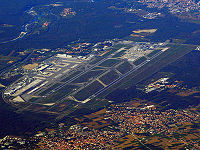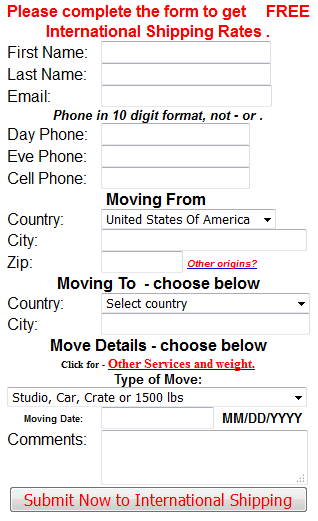Four FREE - International Shipping Quotes to Milan, Italy
With the help of internationalShipping.com international shipping to Milan, Italy can be so much easier! The Best International shipping Companies in the country will compete for your move to Milan, Italy. You will receive up to four free Milan, Italy moving quotes. The information you provide on this web site will only be used for your upcoming move from The United States of America (U.S.A.) to Milan, Italy and will not be transferred or sold to any other vender's .
Milan, Italy
Italy International airport.
Milano Malpensa Airport
 Malpensa
Airport
Malpensa
Airport
"City of Milan" (IATA: MXP, ICAO: LIMC), former "Aeroporto Cittą di Busto Arsizio" is Milan's largest airport. It is located 39.97 km (24.83 mi) northwest of central Milan, Italy. It is one of 3 airports in the Milan metropolitan area.
The airport is connected to Milan by the Milano-Varese highway as well as by the "Malpensa Express" train starting from the Milan Cadorna railway station (LeNord regional railways) and taking about 40 minutes. It is also connected to Linate Airport by a scheduled bus service and by Milan's local transportation. The Milan airport system has a third international airport, Orio al Serio Airport, which serves low-cost traffic.
Malpensa was the 23rd busiest airport in Europe in terms of passengers, handling 17,551,635 passengers in 2009 (25.8 million with Linate, the second airport of Milan, closer to downtown and over 33 million with Orio al Serio Airport, Milan's low-cost airport). As of early 2008, Malpensa remains the top Italian airport in terms of international traffic, together with Rome Leonardo da Vinci Airport in terms of total passengers. As far as hub transit passengers are concerned it is also the second airport in Italy after Rome, according to ASSAEROPORTI traffic data. It is also the leading air freight gateway to Italy. Malpensa serves a population of over 15 million inhabitants.
easyJet has a dedicated Terminal (T2) and Malpensa is that company's biggest base outside the UK.
In 2008 Lufthansa announced plans to create its first Hub outside Germany, and its fourth European hub. In October 2008 Lufthansa set up its Italian division, Lufthansa Italia. SEA (the company which controls Milan's airports) and Lufthansa have a memorandum of understanding for future development and improvement of current facilities. In July 2009 Lufthansa announced that it had requested 10 additional daily slots at Malpensa. As of July 2010, "Lufhtansa Italia" serves fifteen destinations from Milan.
Malpensa has two terminals and a third runway has been announced, and completed in 2012. There is also a dedicated cargo terminal called "CargoCity", which currently handles over 410,000 tons of yearly traffic.
Ground handling services have been slowly deregulated and have seen SEA (the airport authority) create SEA Handling and the arrival of private handler ATA Handling. ATA Handling provides all services apart from bus transport to/from aircraft (originally subcontracted to SEA Handling, now subcontracted to Air Pullman) and disabled assistance. Up to 2001 all ground handling services were provided by SEA and TWA. In the first few years of deregulation some airlines put their own staff for customer assistance but Air One and British Airways realised that it was too expensive and so dismissed them. United Airlines stopped flying to Malpensa. To date the only airline with its own check-in staff remains KLM. Passenger handling is provided by SEA Handling, ATA Handling, Aviapartner, Globeground Italia and ICTS Italia. Ramp services are provided by SEA Handling, ATA and recently Aviapartner. SEA Handling provides 80% of ramp services mostly thanks to its major customer Alitalia.
In May 2006, Italy's Civil Aviation Authority took off the limitation of two ramp handlers. Aviapartner and ARE Group announced that they would create a new company called Aviapartner (owned 51% by Aviapartner and 49% ARE Group) to serve Milan Malpensa and Rome Fiumicino. There are fears that luggage mishandling will go up.
Aviapartner has started operating serving Iberia flights and signing more contracts as time has gone on. However, SEA Handling maintains a dominant position and is reorganising itself to be more competitive by going from a monopolistic mentality to free market one.
Airport security services were transferred in 2000 from the Polizia di Stato (State Police) to SEA which created an internal division called SEA Airport Security. Up to 2002 SEA was assisted by IVRI in providing security services but the contract was not renewed. SEA Airport Security is supervised by Polizia di Stato (Italian State Police), Guardia di Finanza (Italian Military Customs Police) and Ente Nazionale Aviazione Civile (Italy's Civil Aviation Authority). Carabinieri supervise ramp entrance. Furthermore some airlines rely on private security companies (such as ICTS Italia, SEA Airport Security, Gruppo Sicurezza etc.) to provide ID check and airplane guarding.
Milan (Italian: Milano,Western Lombard: Milan,
is a city in Italy and the capital of the region of Lombardy and of
the province of Milan. The city proper has a population of about
1,310,000, while the urban area is the first in Italy and the fifth
largest in the European Union with a population of 4,345,000 over an
area of 2,370 km2 (915 sq mi). The Milan metropolitan area, by far
the largest in Italy, is estimated by the OECD to have a population
of 7,400,000.
The city was founded under the name of Medhlan, by the Insubres,
Celtic people. It was later captured by the Romans in 222 BC, and
the city became very successful under the Roman Empire. Later Milan
was ruled by the Visconti, the Sforza, the Spanish in the 16th
century and the Austrians in the 18th century. In 1796, Milan was
conquered by Napoleon I and he made it the capital of his Kingdom of
Italy in 1805. During the Romantic period, Milan was a major
cultural centre in Europe, attracting several artists, composers and
important literary figures. Later, during World War II, the city was
badly affected by Allied bombings, and after German occupation in
1943, Milan became the main hub of the Italian resistance. Despite
this, Milan saw a post-war economic growth, attracting thousands of
immigrants from Southern Italy and abroad.
An international and cosmopolitan city, 13.9% of Milan's population
is from abroad. The city remains one of Europe's main transportation
and industrial hubs, and Milan is the EU's 10th most important
centre for business and finance (2009) with its economy (see economy
of Milan) being the world's 26th richest by purchasing power,. The
Milan metropolitan area has Europe's 7th GDP in 2008. The province
of Milan (which increasingly is becoming a single administrative
urban unit to supersede the limited commune) had a GDP pp per capita
of around €40,000 in 2007 (161% of the EU 27 average) which was the
highest of any Italian province (Il Sole 24 Ore Quality of life
survey 2008) and the city's workers have the highest average income
rates in Italy, and 26th in the world. In addition, Milan is the
world's 11th most expensive city for expatriate employees, and
according to a 2010 study by the Economist Intelligence Unit, the
city is the world's 12th most expensive to live in. Its economic
environment has made it, according to several studies, the world's
20th and Europe's 10th top business and financial centre, having
been highly successful in terms of city branding.
Milan is recognised as a world fashion and design capital, with a
major global influence in commerce, industry, music, sport,
literature, art and media, making it one of GaWC's major Alpha world
cities. The Lombard metropolis is especially famous for its fashion
houses and shops (such as along Via Monte Napoleone) and the
Galleria Vittorio Emanuele in the Piazza Duomo (reputed to be the
world's oldest shopping mall). The city has a rich cultural heritage
and legacy, a vibrant nightlife, and has a unique cuisine; it is
home to numerous famous dishes, such as the Panettone Christmas cake
and the risotto alla Milanese. The city has a particularly famous
musical, particularly operatic, tradition, being the home of several
important composers (such as Giuseppe Verdi) and theatres (such as
the Teatro alla Scala). Milan is also well-known for containing
several important museums, universities, academies, palaces,
churches and libraries (such as the Academy of Brera and the
Castello Sforzesco) and two renowned football teams: A.C. Milan and
F.C. Internazionale Milano. This makes Milan the 52th Europe's
tourist destination, with over 1.914 million foreign arrivals to the
city in 2008. The city hosted the 1906 World Exposition and will
host the 2015 Universal Exposition.
Inhabitants of Milan are referred to as "Milanese" (Italian:
Milanesi or informally Meneghini or Ambrosiani). The city is
nicknamed by Milan's inhabitants the "moral capital of Italy"
Economy of Milan
Milan is one of the world's major financial and business centers,
and with a 2004 GDP of € 241.2 billion (US$ 312.3 billion), the
Milan metropolitan area has the 4th highest GDPs in Europe: were it
a country, it would rank as the twenty-eighth largest economy in the
world, almost as large as the Austrian economy Milan, according to a
study by the European Regional Economic Growth Index is the 57th
city in Europe for its GDP growth, being surpassed by some other
Italian cities such as Rome and Bologna, yet overcoming Florence.
Milan has also been described as being the world's 20th best
financial city, a far higher result than coming 25th in 2007, as the
10th best business city in Europe, overcoming Geneva, and falling
behind Berlin, and as the 13th fastest improving European city,
improving by 6%.
The city is the seat of the Italian Stock Exchange (the Borsa
Italiana) and its hinterland is the largest industrial area in
Italy. It was included in a list of ten "Alpha world cities" by
Peter J. Taylor and Robert E. Lang of the Brookings Institution in
the economic report "U.S. Cities in the 'World City Network'" (Key
Findings, Full ReportPDF (940 KB)), along with Madrid, Seoul,
Moscow, Brussels, Toronto, Mumbai, Buenos Aires and Kuala Lumpur.
In the late 12th century the arts flourished and the making of
armours was the most important industry. This period saw the
beginning of those irrigation works which still render the Lombard
plain a fertile garden. The development of the wool trade
subsequently gave the first impetus to the production of silk. As in
Venice and Florence, the making of luxury goods was an industry of
such importance that in the 16th century the city gave its name to
the English word “milaner” or “millaner”, meaning fine wares like
jewelry, cloth, hats and luxury apparel. By the 19th century, a
later variant, “millinery”, had come to mean one who made or sold
hats. The industrial revolution in Northern Europe gave a new
prominence to the north area of Milan. It sat on the trade route for
goods coming over the Alps, and built mills powered by water from
the many rivers and streams. In the mid-19th century cheaper silk
began to be imported from Asia and the pest phylloxera damaged silk
and wine production. More land was subsequently given over to
industrialization. Textile production was followed by metal and
mechanical and furniture manufacture.
Today Milan is a major centre for the production of textile and
garments, automobiles (Alfa Romeo), chemicals, industrial tools,
heavy machinery, book and music publishing. FieraMilano, the
exhibition center, had a fair ground known as "FieraMilanoCity",
which was dismantled, except for a few remarkable buildings
(including the cycle sports stadium, built in the '20s), to be house
for an urban development, CityLife, exploiting its vicinity to the
city centre. The new fair ground, in the north-western suburb of
Rho, which was opened in April 2005, makes the Fiera Milano the
largest trade fair complex in the world.

